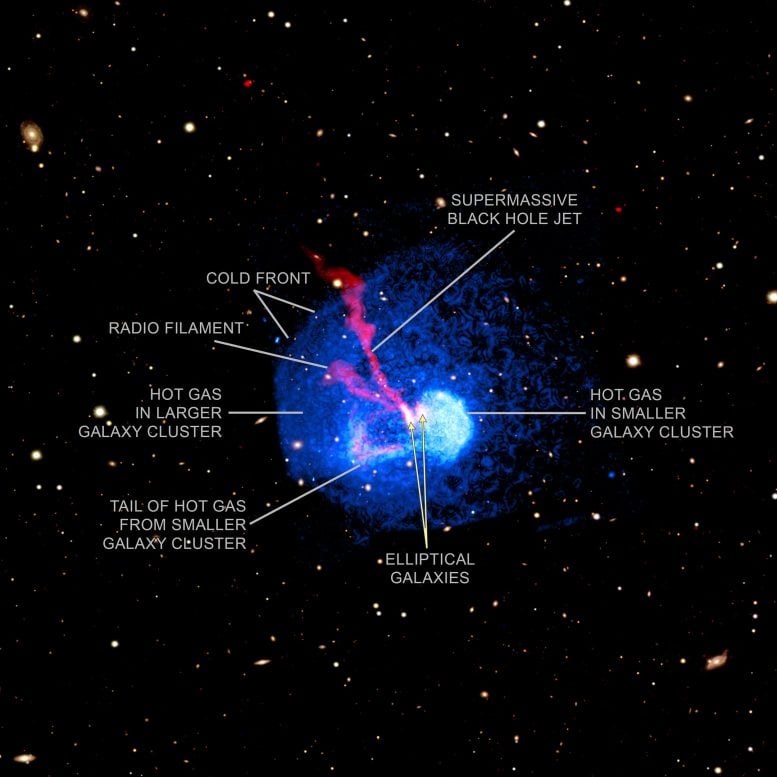
These images of the galaxy cluster Abell 1775 show X-rays from Chandra, optical data from the Pan-STARRS telescope in Hawaii, and radio data from the LOw Frequency ARray (LOFAR) in the Netherlands. A tail from the merged cluster is seen, along with a region of gas with a curved edge, called a “cold front”, that is denser and cooler than the gas it is plowing into (see labeled version). The tail and the cold front all curve in the same direction, creating a spiral appearance. These features are the result of two galaxy clusters — the largest structures held together by gravity — crashing into one another, one of the most energetic events in the Universe. Credit: X-ray: NASA/CXC/Leiden Univ./A. Botteon et al.; Radio: LOFAR/ASTRON; Optical/IR:PanSTARRS
- Abell 1775 is a system where a smaller galaxy cluster has plowed into a larger one.
- Using X-rays from Chandra and data from other telescopes astronomers are piecing together details of this collision.
- Features in the data, including a curving tail of hot gas and a “cold front,” are clues.
- Scientists will likely need more observations and modeling to get the full picture of Abell 1775.
When the titans of space — galaxy clusters — collide, extraordinary things can happen. New research using NASA’s Chandra X-ray Observatory examines the repercussions after two galaxy clusters clashed.
Galaxy clusters are the largest structures in the Universe held together by gravity, containing hundreds or even thousands of individual galaxies immersed in giant oceans of superheated gas. In galaxy clusters, the normal matter — like the atoms that make up the stars, planets, and everything on Earth — is primarily in the form of hot gas and stars. The mass of the hot gas between the galaxies is far greater than the mass of the stars in all of the galaxies. This normal matter is bound in the cluster by the gravity of an even greater mass of dark matter.
Because of the huge masses and speeds involved, collisions and mergers between galaxy clusters are among the most energetic events in the Universe.
In a new study of the galaxy cluster Abell 1775, located about 960 million light-years from Earth, a team of astronomers led by Andrea Botteon from Leiden University in the Netherlands announced that they found a spiral-shaped pattern in Chandra’s X-ray data. These results imply a turbulent past for the cluster.
When two galaxy clusters of different sizes have a grazing collision, the smaller cluster will begin to plow through the larger one. (Because of its superior mass, the bigger cluster has the upper hand when it comes to gravitational pull.) As the smaller cluster moves through, its hot gas is stripped off due to friction. This leaves behind a wake, or tail, that trails behind the cluster. After the center of the smaller cluster passes by the center of the larger one, the gas in the tail starts to encounter less resistance and overshoots the center of its cluster. This can cause the tail to “slingshot” as it flies to the side, curving as it extends away from the cluster’s center.
The newest Chandra data contains evidence — including the brightness of the X-rays and the temperatures they represent — for one of these curving “slingshot” tails. Previous studies of Abell 1775 with Chandra and other telescopes hinted, but did not confirm, that there was an ongoing collision in this system.
A new image of Abell 1775 contains X-rays from Chandra (blue), optical data from the Pan-STARRS telescope in Hawaii (blue, yellow, and white), and radio data from the LOw Frequency ARray (LOFAR) in the Netherlands (red). The tail is labeled in this image along with a region of gas with a curved edge, called a “cold front,” that is denser and cooler than the gas it is plowing into. The tail and the cold front all curve in the same direction, creating a spiral appearance. A separate labeled image (below) shows the field of view of the Chandra data.

Labeled Multiwavelength Image of Abell 1775. Credit: X-ray: NASA/CXC/Leiden Univ./A. Botteon et al.; Radio: LOFAR/ASTRON; Optical/IR:PanSTARRS
Astronomers previously found that Abell 1775 contains an enormous jet and radio source, which is also seen in this new composite image. This jet is powered by a supermassive black hole in a large elliptical galaxy in the cluster’s center. New data from LOFAR and the Giant Metrewave Radio Telescope (GMRT) in India reveals that the radio jet is actually 2.6 million light-years long. This is about twice as long as astronomers thought it was before and makes it one of the longest ever observed in a galaxy cluster. The structure of the jet changes abruptly as it crosses into the lower density gas in the upper part of the image, across the edge of the cold front, implying that the collision has affected it.
According to the new study, the gas motions inside the cluster could be responsible for other structures detected by observing Abell 1775 in radio waves, such as two filaments located near the origin of the jet (one of these is labeled). The LOFAR and Chandra data have also enabled the researchers to study in great detail the phenomena that contribute to accelerating electrons both in this galaxy’s jet and in the radio emission near the center of the larger cluster.
There is an alternate explanation for the appearance of the cluster. As a small cluster approaches a larger one, the dense hot gas of the larger cluster will be attracted to it by gravity. After the smaller cluster passes the center of the other cluster, the direction of motion of the cluster gas reverses, and it travels back towards the cluster center. The cluster gas moves through the center again and “sloshes” back and forth, similar to wine sloshing in a glass that was jerked sideways. The sloshing gas ends up in a spiral pattern because the collision between the two clusters was off-center.
The Botteon team favors the slingshot tail scenario, but a separate group of astronomers led by Dan Hu of Shanghai Jiao Tong University in China favors the sloshing explanation based on data from Chandra and ESA’s XMM-Newton. Both the slingshot and sloshing scenarios involve a collision between two galaxy clusters. Eventually, the two clusters will fully merge with each other to form a single, larger galaxy cluster.
Further observations and modeling of Abell 1775 are required to help decide between these two scenarios.
A paper describing the results by Botteon’s team has been published in the journal Astronomy and Astrophysics. The separate work on the “sloshing” theory led by Dan Hu has been accepted for publication in The Astrophysical Journal.
References:
“Nonthermal phenomena in the center of Abell 1775: An 800 kpc head-tail, revived fossil plasma and slingshot radio halo” by A. Botteon, S. Giacintucci, F. Gastaldello, T. Venturi, G. Brunetti, R. J. van Weeren, T. W. Shimwell, M. Rossetti, H. Akamatsu, M. Brüggen, R. Cassano, V. Cuciti, F. de Gasperin, A. Drabent, M. Hoeft, S. Mandal, H. J. A. Röttgering and C. Tasse, 11 May 2021, Astronomy and Astrophysics.
DOI: 10.1051/0004-6361/202040083
“The Merger Dynamics of the Galaxy Cluster A1775: New Insights from Chandra and XMM-Newton for a Cluster Simultaneously Hosting a Wide-angle Tail and a Narrow-angle Tail Radio Source” by Dan Hu, Haiguang Xu, Zhenghao Zhu, Chenxi Shan, Yongkai Zhu, Shida Fan, Yuanyuan Zhao, Chengze Liu, Hoongwah Siew, Zhongli Zhang, Liyi Gu, Melanie Johnston-Hollitt, Xi Kang, Qinghua Tan, Jiang Chang and Xiang-ping Wu, 18 May 2021, The Astrophysical Journal.
DOI: 10.3847/1538-4357/abf09e
NASA’s Marshall Space Flight Center manages the Chandra program. The Smithsonian Astrophysical Observatory’s Chandra X-ray Center controls science from Cambridge, Massachusetts, and flight operations from Burlington, Massachusetts.









CGI slingshot….liars
Lollllll
To the guy that commented before me
It’s sort of like the glam shots that superstars have taken of th em before they are presented to the public- there was a clear line of activity there, which had to be high-lighted cuz you know Stephen Hawking isn’t likely going to be the only one looking at it
At least it wasn’t face-tuned!